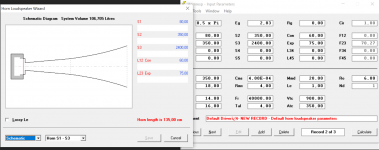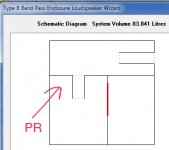 Please attach images like this:
Please attach images like this:How to attach images to your posts.
I have removed your attachment as it was zillions of characters in length and corrupts page loading.
It´s not that I just don´t see the slidebars, I´m also not able to change any of those values
did you follow post 11999 https://www.diyaudio.com/forums/subwoofers/119854-hornresp-1200.html#post6621242 and previous posts about similar problem?
did you follow post 11999 https://www.diyaudio.com/forums/subwoofers/119854-hornresp-1200.html#post6621242 and previous posts about similar problem?
Didn´t see that before, but windows is up to date and Hornresp is located in the correct location, still it doens´t work :/
I can hear it...its not something the average person can pick out...it needs to be rather high in the region where I hear it and must be able to a/b material between the system in question and headphones... it becomes a critical issue for me in the tuning of compression on bass...it makes the bass sound as if it has a compressor on it with a quick release....it also affects perception of the attack envelope in particular an issue with tweaking the attack envelope of a compressor or electric bass instruments.... as a musician and sound engineer I am sensitive to time based distortion....but I have only claimed to hear it in bass...a my current subs are vented with no dampening material which is a classic case for high group delay around tuning. It sounds as a late arrival of lower bass signal in my system...I can pick it out of the play back of various bass drums.
A front loaded horn tuned to 14hz doesn't have group delay issues lol...not to mention that the lower the note the higher group delay has to be for its perception...tuned to 14hz group delay of your horn was like that of a sealed above tuning....that is in comparison to the rest of the spectrum vs tuning where group delay peaks
I never said that it doesn't have group delay. I said that under actual music applications it is not audible. That was the only point of the comparison.
I never YOU said that, it was I who said your horn doesn't have group delay issues lol
David even modeled it for you...
As I said, you horn doesn't have group issues...the whole signal is delayed via the long line length...like in the article recently posted, group delay is an issue of non minimum phase...the difference in gd within your horns passband was ~4ms...thats (highly) optimal...nothing to hear and a bad example for your "experiment"...actually it was the opposite of a great example lol
David even modeled it for you...
As I said, you horn doesn't have group issues...the whole signal is delayed via the long line length...like in the article recently posted, group delay is an issue of non minimum phase...the difference in gd within your horns passband was ~4ms...thats (highly) optimal...nothing to hear and a bad example for your "experiment"...actually it was the opposite of a great example lol
Last edited:
Hi, David.
I recently had been calculated the design of Band Pass type B and ran into a problem: a small port 1 gives high air velocity, and a large port gives a bad frequency response. I think a passive radiator instead of port 1 will solve this problem. Could you please add the option to replace port 1 with a passive radiator in the next versions of the program?
Regards, Artem.
I recently had been calculated the design of Band Pass type B and ran into a problem: a small port 1 gives high air velocity, and a large port gives a bad frequency response. I think a passive radiator instead of port 1 will solve this problem. Could you please add the option to replace port 1 with a passive radiator in the next versions of the program?
Regards, Artem.
Attachments
BP6
Hello
BP6 is an enclosure which has two chambers. First chamber is bigger and tuned to lower frequency, second chamber is smaller, and tuned to higher frequency. tuning frequency of first chamber is near to frequency of the second chamber. The two resonant peaks of each chamber add up and form an even frequency response between the tuning frequencies.
Regards,
Artem
OLA, I am having problems understanding this type of box, since I have little practice in this case
Hello
BP6 is an enclosure which has two chambers. First chamber is bigger and tuned to lower frequency, second chamber is smaller, and tuned to higher frequency. tuning frequency of first chamber is near to frequency of the second chamber. The two resonant peaks of each chamber add up and form an even frequency response between the tuning frequencies.
Regards,
Artem
Could you please add the option to replace port 1 with a passive radiator
Hi Artem,
I will have a look at how much work would be involved, and if it is not too much, I will try to include the option in the next update.
Kind regards,
David
I will have a look at how much work would be involved
I have now had a look - the option will be implemented in the next update.
I have now had a look - the option will be implemented in the next update.
Thank you so much. Is it difficult to add this option for other bandpass enclosures as well?
As DMcBean already mentioned in Post#11943, the displayed impulse response is normalized.Does anyone else have a problem with exporting impulse response from HR and importing it into REW where the imported impulse is around 20dB hotter?
To maximize resolution in the exported 16bit PCM *.wav file, the normalized min/max peak is set to maximum value allowed for a 16bit signed integer.
@ DMcBean,
Since pretty much all current analysis tools support 32bit floating point *.wav files, you might consider adding that as an export option.
This would allow preservation of magnitude so comparison of *.wav file exports from Hornresp would be more meaningful.
I can help with the file format changes.
Last edited:
Is it difficult to add this option for other bandpass enclosures as well?
Not overly difficult, but it would require an awful lot of work. Try the BPB option when it is released and if it proves to be useful / effective, I can then possibly have a look at your next preferred enclosure. A bulk update of all enclosures in the one release is simply too much to contemplate.
I can help with the file format changes.
Many thanks bolserst.
I will send you a copy of the 16-bit code I am currently using, as a starting reference point.
Kind regards,
David
- Home
- Loudspeakers
- Subwoofers
- Hornresp

